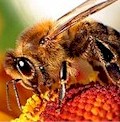Honeybees may just be the most important insects in the world. We rely on them to offer their pollination services to help grow vegetables, fruits, and flowers. They are complicated, organized, and actually quite social among their own. In this article we will focus on the commodities these little critters provide.
The first of these, of course, is the very popular honey. Even though this product is very common in the market, it really takes a long time before this insect completes just a few drops of this golden sweet.
The first step involves collecting nectar from flowers, and transporting it back to the hive. The foraging bee carries this nectar in it's 'honey stomach' adding enzymes as it goes to start it's transformation into honey. It is then deposited in a honeycomb cell, where worker bees fan their wings over the cell until the moisture content is correct (17-18%). Then the cell is sealed and the honey is ready to eat.
This product is used in various ways by humans. It is an easy substitute for sugar, in making sweets, and even is used for medicinal purposes.
Another popular product from honeybees is the royal jelly. This substance is secreted by the glands of the worker bees and was given its name because it is the sole food source of the queen bee. It is fed to the mother of the hive during her larval and whole adult life.
Royal jelly is milky-white in color and has a bitter taste and prudent acidic smell. In human consumption, this product is commonly used as ingredients in creams, cosmetics, lotions, and even dietary supplements because of their high vitamins B, C, D, and protein content.
Beeswax is another infamous produce from these insects and are gathered as secretions from the wax glands of worker bees. This wax is mainly used in candle making and in cosmetics like cold creams, lotions, lipsticks, ointments and also as coatings for electrical materials and pills.
Honeybees are also the collectors of propolis which they originally use as glue or sealant for some cracks on their hives. Gathered from trees and other plants, this material is very sticky - as all beekeepers will know, once you get it on your hands it is very difficult to get off!
When it comes to human use, this produce is used for medical purposes as dressing for both man and animal wounds. When added with alcohol tincture, it is also believed to be a good solution for hearing problems while it can turn to violin varnish when mixed with mineral spirits.
The last and probably most important function of these little workers is pollination. Since many of other natural pollinators are now becoming scarce, human kind now depends so much in these little winged ones to disperse pollen for the flowers, fruits, and vegetables important for living. Without them, important crops wouldn't flourish and food shortages would be a real possibility.
Indeed, helping to do their bit for both mother nature and for the human race is one of the (many) reasons why more and more people have decided to start beekeeping - why not join them?
